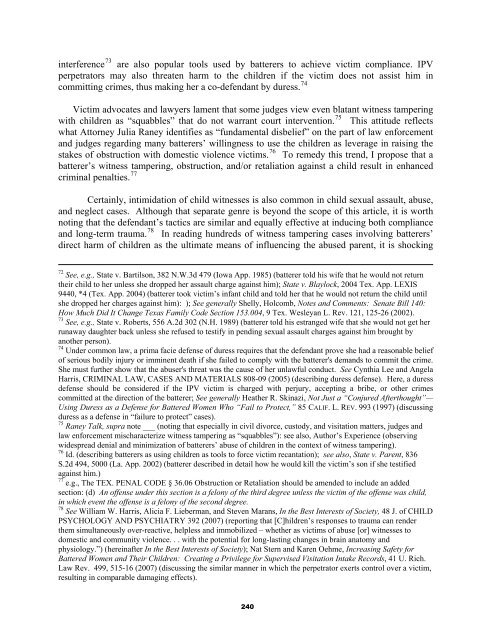A Judge’s Guide
A Judge’s Guide
A Judge’s Guide
Create successful ePaper yourself
Turn your PDF publications into a flip-book with our unique Google optimized e-Paper software.
interference 73 are also popular tools used by batterers to achieve victim compliance. IPV<br />
perpetrators may also threaten harm to the children if the victim does not assist him in<br />
committing crimes, thus making her a co-defendant by duress. 74<br />
Victim advocates and lawyers lament that some judges view even blatant witness tampering<br />
with children as “squabbles” that do not warrant court intervention. 75 This attitude reflects<br />
what Attorney Julia Raney identifies as “fundamental disbelief” on the part of law enforcement<br />
and judges regarding many batterers’ willingness to use the children as leverage in raising the<br />
stakes of obstruction with domestic violence victims. 76 To remedy this trend, I propose that a<br />
batterer’s witness tampering, obstruction, and/or retaliation against a child result in enhanced<br />
criminal penalties. 77<br />
Certainly, intimidation of child witnesses is also common in child sexual assault, abuse,<br />
and neglect cases. Although that separate genre is beyond the scope of this article, it is worth<br />
noting that the defendant’s tactics are similar and equally effective at inducing both compliance<br />
and long-term trauma. 78<br />
In reading hundreds of witness tampering cases involving batterers’<br />
direct harm of children as the ultimate means of influencing the abused parent, it is shocking<br />
72 See, e.g., State v. Bartilson, 382 N.W.3d 479 (Iowa App. 1985) (batterer told his wife that he would not return<br />
their child to her unless she dropped her assault charge against him); State v. Blaylock, 2004 Tex. App. LEXIS<br />
9440, *4 (Tex. App. 2004) (batterer took victim’s infant child and told her that he would not return the child until<br />
she dropped her charges against him): ); See generally Shelly, Holcomb, Notes and Comments: Senate Bill 140:<br />
How Much Did It Change Texas Family Code Section 153.004, 9 Tex. Wesleyan L. Rev. 121, 125-26 (2002).<br />
73 See, e.g., State v. Roberts, 556 A.2d 302 (N.H. 1989) (batterer told his estranged wife that she would not get her<br />
runaway daughter back unless she refused to testify in pending sexual assault charges against him brought by<br />
another person).<br />
74 Under common law, a prima facie defense of duress requires that the defendant prove she had a reasonable belief<br />
of serious bodily injury or imminent death if she failed to comply with the batterer's demands to commit the crime.<br />
She must further show that the abuser's threat was the cause of her unlawful conduct. See Cynthia Lee and Angela<br />
Harris, CRIMINAL LAW, CASES AND MATERIALS 808-09 (2005) (describing duress defense). Here, a duress<br />
defense should be considered if the IPV victim is charged with perjury, accepting a bribe, or other crimes<br />
committed at the direction of the batterer; See generally Heather R. Skinazi, Not Just a “Conjured Afterthought”—<br />
Using Duress as a Defense for Battered Women Who “Fail to Protect,” 85 CALIF.L.REV. 993 (1997) (discussing<br />
duress as a defense in “failure to protect” cases).<br />
75 Raney Talk, supra note ___ (noting that especially in civil divorce, custody, and visitation matters, judges and<br />
law enforcement mischaracterize witness tampering as “squabbles”): see also, Author’s Experience (observing<br />
widespread denial and minimization of batterers’ abuse of children in the context of witness tampering).<br />
76 Id. (describing batterers as using children as tools to force victim recantation); see also, State v. Parent, 836<br />
S.2d 494, 5000 (La. App. 2002) (batterer described in detail how he would kill the victim’s son if she testified<br />
against him.)<br />
77 e.g., The TEX. PENAL CODE § 36.06 Obstruction or Retaliation should be amended to include an added<br />
section: (d) An offense under this section is a felony of the third degree unless the victim of the offense was child,<br />
in which event the offense is a felony of the second degree.<br />
78 See William W. Harris, Alicia F. Lieberman, and Steven Marans, In the Best Interests of Society, 48 J. of CHILD<br />
PSYCHOLOGY AND PSYCHIATRY 392 (2007) (reporting that [C]hildren’s responses to trauma can render<br />
them simultaneously over-reactive, helpless and immobilized – whether as victims of abuse [or] witnesses to<br />
domestic and community violence. . . with the potential for long-lasting changes in brain anatomy and<br />
physiology.”) (hereinafter In the Best Interests of Society); Nat Stern and Karen Oehme, Increasing Safety for<br />
Battered Women and Their Children: Creating a Privilege for Supervised Visitation Intake Records, 41 U. Rich.<br />
Law Rev. 499, 515-16 (2007) (discussing the similar manner in which the perpetrator exerts control over a victim,<br />
resulting in comparable damaging effects).<br />
240


